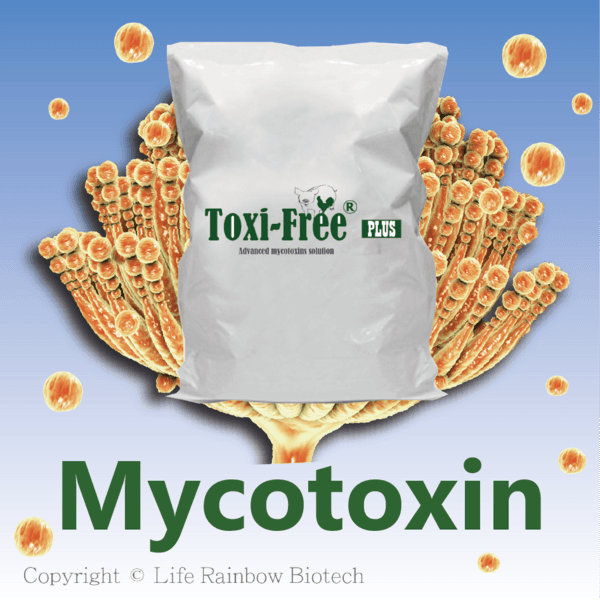
Mycotoxins semiannual survey of mycotoxin in feed in 2023 Taiwan
Aflatoxins | Zearalenone | Fumonisins | DON | |
Sample number | 141 | 141 | 141 | 141 |
% of positive | 69.5 | 58.9 | 80.1 | 64.5 |
Average of positive (ppb) | 2.39 | 127 | 1230 | 931 |
Max of positive (ppb) | 15.82 | > 1000 | > 5000 | > 5000 |
Aflatoxins | Zearalenone | Fumonisins | DON | |
Sample number | 30 | 30 | 30 | 30 |
% of positive | 20.0 | 33.3 | 70.0 | 60.0 |
Average of positive (ppb) | 1.52 | 88 | 1170 | 708 |
Max of positive (ppb) | 1.77 | 379 | > 5000 | 1641 |
Zearalenone | Fumonisins | DON | ||
Sample number | 22 | 22 | 22 | 22 |
% of positive | 90.9 | 68.2 | 50.0 | 72.7 |
Average of positive (ppb) | 1.84 | 54 | 508 | 851 |
Max of positive (ppb) | 3.08 | 173 | 1783 | > 5000 |
Aflatoxins | Zearalenone | Fumonisins | DON | |
Sample number | 55 | 55 | 55 | 55 |
% of positive | 85.5 | 58.2 | 87.3 | 60.0 |
Average of positive (ppb) | 2.57 | 55 | 1028 | 653 |
Max of positive (ppb) | 4.82 | 168 | 3496 | 3779 |
In special reference to Swine feed, especially to gilt and pregnant sow feed; in the Indian sub continent, Mycotoxins play a major role in drop in productivity. Here, Aflatoxin, Zearalenone, DON etc are more frequently found, both in raw materials as well in the finished feed. North East India is a bigger pocket of the Swine industry, both in Production and Consumption. But due to the lack of detection of toxins in the RM and limited use of proper toxin binders, the overall productivity was hampered.
NEOGEN, in this scenario, brought the solution with a rapid Mycotoxin testing method, both in the feed production site as well as in the farmer side; which helps in early detection of the toxins and takes necessary action at the earliest.
Mycotoxin management in Poultry.
1. Today, we have been witnessing a steady tendency in the increase of global demand for maize, wheat, soybeans, and their products due to the steady growth and strengthening of the livestock industry.
a) The rain has dashed the dreams of several farmers who were expecting good crop this year.
b) Adverse weather conditions were the main contributing factor to reduced yield and crop quality across the states of Karnataka, Andhra Pradesh, Telangana and Maharashtra.
2. Thus, animal feed safety has gradually become more important, with mycotoxins representing one of the most significant hazards.
3. Mycotoxins comprise different classes of secondary metabolites of molds. With regard to animal feed, aflatoxins, fumonisins, ochratoxins, trichothecenes, and zearalenone are the more prevalent.
4. Poultry feed ingredients are derived from a variety of raw materials that originate from plants and animals.
a) It is usually a mixture of cereals mostly maize that serves as energy source,
b) animal protein sources (fish meal, meat, and bone meal), and plant protein sources (soybean meal, etc).
5. Maize, the predominant grain used in poultry feeds, can be contaminated by mycotoxins from Aspergillus, Fusarium and Penicillium during processing and storage (Zinedine and Manes 2009; Adetunji et al. 2014).
b) Groundnut and its processed products have been found to be highly susceptible to aflatoxin contamination (Ezekiel et al. 2012b, 2013; Kayode et al. 2013; Oyedele et al. 2017; Ginting et al. 2018).
6. Globally, mycotoxins in finished poultry feed have been reported (Labuda et al. 2005; De Boevre et al. 2012; Ezekiel et al. 2012a; Njobeh et al. 2012; Rodrigues and Naehrer 2012; Abia et al. 2013a; Kana et al. 2013; Streit et al. 2013b)
7. While the types and levels of mycotoxins in the feed largely depend:
a) on the mycotoxins in the individual feed ingredients,
b) the mix/proportion of feed ingredients,
c) feed processing techniques,
d) and storage practices (Warth et al. 2012; Ezekiel et al. 2014).
8. When animals ingest feed contaminated with high mycotoxin concentrations, mycotoxicoses,
a) often marked by reduced animal productivity,
b) reduced body weight gain,
c) reduced litter sizes,
d) deformed offspring,
e) reduced egg production
f) leg problems and weakness
g) and immune suppression (Shareef 2010; Hossain et al. 2011; Streit et al. 2013a) which could result to severe economic losses.
9. Prevention and control:
a) Prevention of mycotoxin production can be done by keeping feeds fresh,
b) keeping humidity level less than 11%,
c) Removal of toxic feed and it should be replaced with unadulterated feed.
d) keeping equipments clean, proper ventilation in storehouse,
e) and adding Toxin binders.
10. Feed to food chain is interlinked and need a holistic focus on safety. Hygiene and safety of feed can be achieved by
Choosing right Toxin binders which only binds Mycotoxins.
11. Effective mycotoxin management is about seeing the whole challenge:
a) from the farm to feed mill and from risk assessment to feed management,
b) The symptoms can be many and varied,
c) but the outcome in all cases will be reduced performance and lost profit.
Dr V. Rajendra Prasad




.jpg&w=3840&q=75)